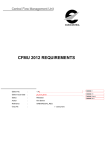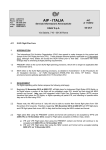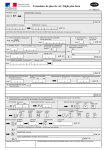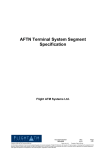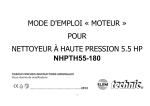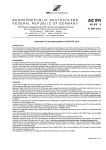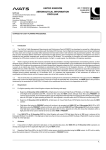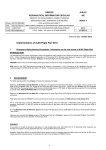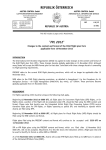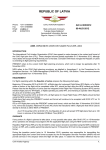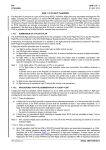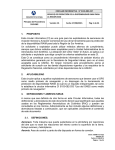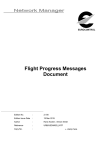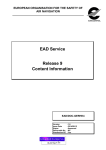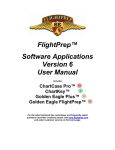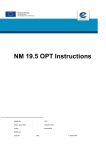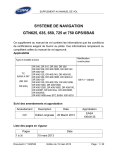Download CFMU INTERFACE MANUAL FOR ICAO 2012
Transcript
EUROCONTROL CFMU INTERFACE MANUAL FOR ICAO 2012 NEW FLIGHT PLAN CONTENT INTRODUCED BY AMENDMENT 1 TO DOC 4444 (PANS-ATM) DATE: VERSION: 10 AUGUST 2011 1.31 Deleted: 1 Deleted: JULY Deleted: 3 PAGE INTENTIONALLY LEFT EMPTY 1.31 Page | 2 RECORD OF AMENDMENTS Version Date Reason for the amendment Pages affected 0.1 22-022010 Creation for the first straw-man All 0.2 01-032010 First draft text added All 0.3 27-032010 Draft text in amendment detail section added All 0.4 03-042010 Comments incorporated, new text added All 0.5 15-042010 Title changed; procedures for the use of DOF/ added All 1.0 07-052010 Released version All 1.1 09-062010 Correction of IFP/ indicator Transition guidance for AOs improved Translation table – EUR/ added 1.2 23-122010 Inclusion of amendments agreed by Task Force 23 Sept 2010 and approved by ODSG21 17-18 Nov 2010 1.3 01-072011 Inclusion of amendment concerning placement of exemption indicators as agreed via EANPG COG/50 Correction of inconsistency with ADEXP definition of depz, desz 1.31 P. 26 P. 42 P. 51 P. 20 P. 22 P. 23 P. 28 P 32-34 P. 37-38 P. 42-52 P. 25 P. 29-34 P. 37 P. 42 Page | 3 1.31 1.31 10-082011 Update of translation table to reflect the use of COM/, NAV/, DAT/ for the relevant exemption indicators P. 51-52 Page | 4 TABLE OF CONTENTS record of amendments..................................................................................................................................................2 record of amendments..................................................................................................................................................3 Table of contents...........................................................................................................................................................5 1. GLOSSARY OF ABBREVIATIONS............................................................................................................11 2. DEFINITION OF TERMS.........................................................................................................................12 3. OBTAINING DOCUMENTS ....................................................................................................................12 4. INTRODUCTION....................................................................................................................................12 4.1. BACKGROUND INFORMATION.............................................................................................................12 4.2. PURPOSE OF THE DOCUMENT.............................................................................................................13 4.3. SCOPE OF THE DOCUMENT..................................................................................................................13 4.4. STRUCTURE OF THE DOCUMENT .........................................................................................................13 4.5. RELATIONSHIP WITH THE IFPS AND RPL DICTIONARY OF MESSAGES (DOM) .....................................14 4.6. RELATIONSHIP WITH THE B2B FLIGHT SERVICES .................................................................................14 5. AMENDMENT SUMMARY ....................................................................................................................14 5.1. CHANGES OF A GENERAL NATURE.......................................................................................................14 5.1.1. PUBLICATION OF SIGNIFICANT DIFFERENCES FROM PANS-ATM DOC 4444 .......................................14 5.1.2. EARLY SUBMISSION LIMIT OF FLIGHT PLANS.......................................................................................14 5.1.3. TRANSMISSION OF FLIGHT PLAN (FPL) MESSAGES..............................................................................14 5.1.4. INDICATION OF THE DATE OF FLIGHT..................................................................................................14 5.1.5. ADDRESSEES OF MODIFICATION (CHG) MESSAGES.............................................................................15 5.1.6. INTRODUCTION OF THE TERM DESTINATION ALTERNATE AERODROME............................................15 5.1.7. USE OF THE TERM SIGNIFICANT POINT ...............................................................................................15 5.1.8. PROMINENCE GIVEN TO DOC 7910 – LOCATION INDICATORS............................................................15 1.31 Page | 5 5.1.9. THE MOST IMPORTANT CHANGES ARE IN ITEM 10 AND ITEM 18.......................................................15 5.2. ICAO MODEL FLIGHT PLAN FORM ITEMS AFFECTED ...........................................................................15 5.2.1. ITEM 7: AIRCRAFT IDENTIFICATION .....................................................................................................16 5.2.2. ITEM 8: FLIGHT RULES AND TYPE OF FLIGHT .......................................................................................16 5.2.3. ITEM 10: EQUIPMENT AND CAPABILITIES............................................................................................16 5.2.4. ITEM 13: DEPARTURE AERDROME AND TIME .....................................................................................17 5.2.5. ITEM 15: ROUTE...................................................................................................................................17 5.2.6. ITEM 16: DESTINATION, TOTAL ESTIMATED ELAPSED TIME, DESTINATION ALTERNATE ....................17 5.2.7. ITEM 18: OTHER INFORMATION ..........................................................................................................18 5.3. REPETITIVE FLIGHT PLAN LISTING FORM .............................................................................................18 5.4. ICAO FIELD TYPES AFFECTED................................................................................................................18 5.5. ICAO ATS MESSAGE TYPES AFFECTED..................................................................................................19 5.6. EXCHANGES WITH THE CFMU AFFECTED BY THE AMENDMENT.........................................................19 5.7. MESSAGES AFFECTED IN THE CFMU MESSAGE EXCHANGE.................................................................20 5.7.1. MESSAGES RECEIVED BY THE CFMU ....................................................................................................20 5.7.2. MESSAGES SENT BY THE CFMU ...........................................................................................................20 6. THE AMENDMENT IN DETAIL...............................................................................................................21 6.1. MESSAGE DESCRIPTION METHOD .......................................................................................................21 6.2. FIELD DEFINITIONS...............................................................................................................................21 6.2.1. FIELD 10 ...............................................................................................................................................21 6.2.1.1. FIELD 10A – EQUIPMENT AND CAPABILITIES.......................................................................................21 6.2.1.2. FIELD 10B – SURVEILLANCE EQUIPMENT AND CAPABILITIES ..............................................................22 6.2.1.3. AFTN CONSTRAINTS.............................................................................................................................23 6.2.2. FIELD 18 – OTHER INFORMATION........................................................................................................23 6.2.2.1. INPUT TO IFPS ......................................................................................................................................23 6.2.2.2. OUTPUT FROM IFPS .............................................................................................................................24 6.2.2.3. USE OF THE INDICATORS IN FIELD 18 ..................................................................................................25 1.31 Page | 6 6.2.2.3.1. STS/ ......................................................................................................................................................25 6.2.2.3.2. RMK/ ....................................................................................................................................................26 6.2.2.3.3. RVR/ .....................................................................................................................................................26 6.2.2.3.4. RFP/......................................................................................................................................................27 6.2.2.3.5. SRC/......................................................................................................................................................27 6.2.2.3.6. IFP/.......................................................................................................................................................28 6.2.2.3.7. AWR/....................................................................................................................................................28 6.2.2.3.8. STAYINFOn/..........................................................................................................................................29 6.2.2.3.9. EUR/ .....................................................................................................................................................29 6.2.2.3.10. PBN/.....................................................................................................................................................30 6.2.2.3.11. DAT/ .....................................................................................................................................................31 6.2.2.3.12. SUR/ .....................................................................................................................................................31 6.2.2.3.13. DEP/ .....................................................................................................................................................32 6.2.2.3.14. DEST/ ...................................................................................................................................................32 6.2.2.3.15. DLE/......................................................................................................................................................33 6.2.2.3.16. PER .......................................................................................................................................................34 6.2.2.3.17. ALTN/ ...................................................................................................................................................35 6.2.2.3.18. RALT/....................................................................................................................................................35 6.2.2.3.19. TALT/....................................................................................................................................................36 6.2.2.3.20. NAV/.....................................................................................................................................................36 6.2.2.3.21. COM/ ...................................................................................................................................................37 6.2.2.3.22. TYP/......................................................................................................................................................38 6.2.2.3.23. ORGN/..................................................................................................................................................38 6.2.2.3.24. REG/ .....................................................................................................................................................39 6.3. RULES CONCERNING FLIGHT PLAN ASSOCIATED MESSAGES...............................................................39 6.3.1. ALL MESSAGES .....................................................................................................................................39 6.3.2. USE OF DOF/ ........................................................................................................................................39 1.31 Page | 7 6.3.3. MESSAGES SENT TO THE IFPS ..............................................................................................................40 6.3.4. MESSAGES SENT BY THE IFPS...............................................................................................................41 6.4. RULES CONCERNING THE FLIGHT PROGRESS MESSAGES AFP, APL AND ACH .....................................41 6.4.1. GENERAL ..............................................................................................................................................41 6.4.2. THE EQCST FIELD..................................................................................................................................41 6.4.2.1. EQCST FIELD SYNTAX ...........................................................................................................................41 6.4.2.2. HANDLING OF SURVEILLANCE DATA....................................................................................................42 6.4.2.2.1. EQUIPMENT CLASS AND CAPABILITY INDICATIONS.............................................................................42 6.4.2.3. HANDLING OF OTHER DATA ................................................................................................................42 6.4.3. SPECIFIC RULE CONCERNING THE ACH MESSAGE ...............................................................................43 6.5. ATFM FLIGHT PROGRESS MESSAGES ...................................................................................................43 7. RECOGNISING OLD AND NEW..............................................................................................................43 7.1. GENERAL CONSIDERATIONS ................................................................................................................43 7.2. THE DECISION LOGIC............................................................................................................................43 7.2.1. RECOGNISING NEW CONTENT.............................................................................................................43 7.2.2. RECOGNISING OLD CONTENT ..............................................................................................................44 7.3. ADDITIONAL RULES..............................................................................................................................44 8. TRANSITION PROCESS..........................................................................................................................44 8.1. TRANSITION - AIRSPACE USERS ...........................................................................................................44 8.1.1. GENERAL ..............................................................................................................................................44 8.1.2. SPECIAL CONSIDERATIONS FOR FILING AROUND THE CUT-OVER DATE..............................................44 8.1.3. SPECIAL CONSIDERATIONS FOR FILING RPL LISTS................................................................................45 8.2. TRANSITION - AIR NAVIGATION SERVICE PROVIDERS .........................................................................45 8.3. IFPS PROCESSING MODES IN SUPPORT OF THE TRANSITION ..............................................................45 8.3.1. PROCESSING MODE 1 – ACCEPTANCE OF OLD FORMAT ONLY ...........................................................45 8.3.2. PROCESSING MODE 2 – ACCEPTANCE OF NEW AND OLD FORMAT ....................................................45 8.3.3. PROCESSING MODE 3 – ACCEPTANCE OF NEW FORMAT ONLY ..........................................................46 1.31 Page | 8 8.4. THE IFPS TRANSLATION FUNCTION .....................................................................................................46 8.4.1. GENERAL RULES ...................................................................................................................................46 8.4.2. COM/NAV/SUR TRANSLATION TABLE..................................................................................................46 8.4.3. TRANSLATION OF FIELD 18 INDICATORS NOT COVERED IN 8.4.2........................................................53 8.4.4. RULES FOR FIELD 10B CHOICE .............................................................................................................55 1.31 Page | 9 PAGE INTENTIONALLY LEFT EMPTY 1.31 Page | 10 1. GLOSSARY OF ABBREVIATIONS When used in this document, the abbreviations shown here will have the meaning indicated below. ACARS Aircraft Communications Addressing and Reporting System ADEXP ATS Data Exchange Presentation ADF Automatic Direction Finder ADS-B Automatic Dependent Surveillance - Broadcast ADS-C Automatic Dependent Surveillance - Contract AIP Aeronautical Information Publication ATM Air Traffic Management ATS Air Traffic Services B2B Business to Business CFMU Central Flow Management Unit D-FIS Digital Flight Information Service DOF Off Block Date DOM Dictionary of Messages EOBD Estimated Off Block Date EOBT Estimated Off Block Time FPLSG Flight Plan Study Group 1.31 Page | 11 GNSS Global Navigation Satellite System ICAO International Civil Aviation Organisation IFPS Integrated Initial Flight Plan Processing System IFPZ IFPS Zone OAT Operational Air Traffic PANS Procedures for Air Navigation Services PBN Performance Based Navigation RPL Repetitive Flight Plan VFR Visual Flight Rules VOR VHF Omni-directional Radio Range 2. DEFINITION OF TERMS All terms used in this document have as their meaning the definitions contained for the same term in the appropriate ICAO or EUROCONTROL publications. 3. OBTAINING DOCUMENTS Further copies of this document and the documents mentioned in the text may be obtained from the Central Flow Management Unit (CFMU) via the web http://www.cfmu.eurocontrol.int/cfmu/public/standard_page/cfmu_programmes_fpl_2012.html or by writing to CFMU CUSTOMER SUPPORT at [email protected]. 4. INTRODUCTION 4.1. BACKGROUND INFORMATION 1.31 Page | 12 The ICAO provisions governing the contents of Flight Plans, Flight Plan messages and Flight Plan associated messages, are contained in the ICAO document entitled “Procedures for Air Navigation Services – Air Traffic Management (PANS-ATM, Doc 4444)”. Amendment 1 to this ICAO document has been approved on 27 May 2008 and becomes applicable on 15 November 2012. This Amendment stems from the work of the Flight Plan Study Group (FPLSG) and its nature and scope is to update the ICAO model flight plan form in order to meet the needs of aircraft with advanced capabilities and the evolving requirements of automated air traffic management (ATM) systems, while taking into account the need for compatibility with existing systems, human factors, training, cost and transition aspects. The changes introduced in the ICAO model flight plan form have an effect on Flight Plan messages and Flight Plan associated messages if and when they contain Field Types affected by the Amendment. In order to retain compatibility, all products that use the amended Field Types must be updated also. One of these products is ADEXP, the ATS data exchange presentation used by the Central Flow Management Unit’s (CFMU) Integrated Initial Flight Plan Processing System (IFPS) component in Europe. These changes to the flight plan are meant to address the immediate requirements for a better match with recent developments in air traffic management. A more fundamental set of changes is expected in the coming years which will also cater for the longer term developments in ATM. 4.2. PURPOSE OF THE DOCUMENT This document describes the changes to the various Items in the ICAO model flight plan form and the consequent modifications to the message Field Types (ICAO) and Fields (ADEXP). Its purpose is to provide the necessary guidance for users involved in generating and processing Flight Plans and Flight Plan associated messages (including both the ICAO set and those specific to the CFMU operation). 4.3. SCOPE OF THE DOCUMENT The description in the initial edition of this document is limited to those items that are subject to change as a result of Amendment 1 to PANS-ATM Doc 4444. Its structure however allows the easy addition of information on other items as required and later editions may in fact be expanded to include all items of the ICAO model flight plan form, upgrading the document to general guidance material. 4.4. STRUCTURE OF THE DOCUMENT The document has an introductory part giving the background, followed by two main sections. The first of these provides a summary of the changes introduced by Amendment 1 to PANS-ATM, the second describes the resulting changes in terms of the applicable new syntax and specific rules to be taken into account. This latter section focuses on the field types affected but it also contains information specific to certain messages where the usage or processing of the message as such is affected. Some messages and their descriptions are of concern only to air navigation service providers and airspace users may safely ignore the relevant information included in this document. 1.31 Page | 13 4.5. RELATIONSHIP WITH THE IFPS AND RPL DICTIONARY OF MESSAGES (DOM) As stated earlier, this document has been created to guide users in transitioning to the new flight plan resulting from Amendment 1 to PANS-ATM Doc. 4444. As such it focuses only on those elements of the flight plan affected by the amendment. Complete syntax information on the various messages is available in the CFMU publication entitled “IFPS and RPL Dictionary of Messages”, available on request from EUROCONTROL. 4.6. RELATIONSHIP WITH THE B2B FLIGHT SERVICES This document does not cover the changes necessary in the Business-to-Business (B2B) flight services descriptions. These will be described in the updated edition of the B2B Flight Services Reference Manual available from EUROCONTROL. 5. AMENDMENT SUMMARY 5.1. CHANGES OF A GENERAL NATURE Although Amendment 1 to PANS-ATM Doc 4444 is meant primarily to update the ICAO model flight plan form, ICAO has used this instrument to introduce a number of long overdue other changes (see 5.1.1 below) also. There are also several small but important consequential changes contained in the Amendment. Below you will find a short description of all changes, arranged in the order they appear in Doc 4444. The details of the syntax to be used after the Amendment has been implemented are contained in Section 6. 5.1.1. PUBLICATION OF SIGNIFICANT DIFFERENCES FROM PANS-ATM DOC 4444 Until 1 October 1973, differences from PANS documents were published in supplements to the document concerned. After that date, significant differences are to be published in State Aeronautical Information Publications (AIP). However, Doc 4444 has not been previously updated to reflect this change in the context of flight plan related differences. The omission has now been rectified. 5.1.2. EARLY SUBMISSION LIMIT OF FLIGHT PLANS A new provision now specifies that flight plans shall not be submitted more than 120 hours before the estimated off-block time of a flight. 5.1.3. TRANSMISSION OF FLIGHT PLAN (FPL) MESSAGES The old provisions required that a flight plan “shall normally” be transmitted immediately after filing of the flight plan. This now has been changed to a “should” and it must be seen in connection with another change that eliminates the possibility of withholding the transmission of an FPL message under certain conditions until one hour before the estimated off-block time. In other words, the flight plan message should now be transmitted immediately after the filing of the flight plan, regardless of any other considerations. 5.1.4. 1.31 INDICATION OF THE DATE OF FLIGHT Page | 14 It is now mandatory to insert in Item 18 the date of flight departure if the flight plan is filed more than 24 hours in advance of the estimated off-block time of the flight. This reverses the previous provision which specified that such flight plans be held in abeyance until at most 24 hours before departure so as to avoid the need to insert the date group in the flight plan. This change is likely to have only a limited impact since the requirement to insert the date of flight in such early filings has been in effect in many places already. 5.1.5. ADDRESSEES OF MODIFICATION (CHG) MESSAGES The original provisions stipulated that the CHG message shall be sent to those recipients of basic flight plan data which are affected by the change. This has now been qualified with a new provision that limits this requirement to cases where the affected entities have not previously received the relevant revised basic flight plan data. 5.1.6. INTRODUCTION OF THE TERM DESTINATION ALTERNATE AERODROME The Alternate Aerodrome is now being referred to as the “Destination alternate aerodrome”. This change ensures clarity in respect of the difference between the destination alternate aerodrome(s) to be shown in Item 16 of the ICAO model flight plan form and the en-route and take-off alternate aerodromes which are to be included in Item 18 if applicable. 5.1.7. USE OF THE TERM SIGNIFICANT POINT The term significant point has been defined already and it refers to a geographical location used in defining an ATS route or the flight path of an aircraft and for other navigation and ATS purposes. Accordingly, a significant point may or may not be marked by the position of a navigation aid like a VOR for instance. In previous descriptions in the ICAO model flight plan form the term navigation aid was used extensively even though the point referred to was not necessarily also the location of a navigation aid (but, according to the definition, was always a significant point). This discrepancy has now been removed and the term significant point is used throughout the ICAO model flight plan form. 5.1.8. PROMINENCE GIVEN TO DOC 7910 – LOCATION INDICATORS Although the use of the ICAO four-letter location indicators has been prescribed and common practice also in the past, the Amendment now introduces direct references to Doc 7910 – Location Indicators as the only allowed source of four-letter location indicators to be used in flight plans. This is meant to counter the practice of “inventing” four-letter location indicators for aerodromes not yet provided with one. This practice can lead to confusion and operational problems in automated systems. 5.1.9. THE MOST IMPORTANT CHANGES ARE IN ITEM 10 AND ITEM 18 Although we will discuss in detail the changes to all the Items affected, it is perhaps worthwhile to mention also in this general section that the most extensive modifications are to be found in Item 10 which is now called Equipment and Capabilities (was just Equipment in the past) and in Item 18 – Other Information which becomes the repository of a wide range of information all of which is subject to very strict syntax rules. 5.2. ICAO MODEL FLIGHT PLAN FORM ITEMS AFFECTED The various Items in the ICAO model flight plan form have been affected in one or both of the following ways: 1.31 Page | 15 • Clarification only (e.g. the term “alphanumeric” added before the term “characters”) or bringing examples up to date (e.g. elimination of a reference to SABENA); • Change in substance (e.g. new letters to indicate aircraft capabilities). Complete familiarity with these changes is essential, since changes in the various ATS messages are all related to changes of the Items in the ICAO model flight plan form. In the following, we will review each of the Items affected and provide a summary of the changes. Pure editorial changes and changes on the level of general notes have not been included in this summary. The relevant syntax rules will be described in Section 6. 5.2.1. ITEM 7: AIRCRAFT IDENTIFICATION Type of change: clarification/updating. Changes in detail: • The term “alphanumeric” has been inserted in front of the term “characters” and it has been clarified that no hyphens or symbols may be used in this Item; • Instead of referring simply to the registration marking of the aircraft, the instruction now is to include “the nationality or common mark and registration mark” of the aircraft; • The examples have been updated; • A new note points to ICAO Annex 7, Chapter 2 as the source of nationality, common and registration marks. 5.2.2. ITEM 8: FLIGHT RULES AND TYPE OF FLIGHT Type of change: clarification. Changes in detail: • It has been clarified in the part on Flight Rules that the first point where a change of flight rules is planned may be the only instance of such a change or one of several changes. Furthermore, the reference to the use of Item 15 has been cleaned up editorially; • The Type of Flight part now includes a specific instruction to specify the Status in Item 18, using either the STS or the RMK indicator. 5.2.3. ITEM 10: EQUIPMENT AND CAPABILITIES Type of change: change in substance. Changes in detail: • 1.31 The term “capabilities” and its definition is introduced. From now on the list of equipment and the list of aircraft capabilities in detail can be indicated. The letter “S” is still available to indicate the availability of Page | 16 standard equipment for the route to be flown (i.e. without indicating further detail), however, ADF is no longer considered as part of the standard set; • Item 18 is now indicated as the place to include equipment and capability details in respect of a much broader set of indicator letters; • Some of the single letters indicating equipment/capabilities have now become letter/number combinations (e.g. E2 for D-FIS ACARS); • The use on a regional basis of non-allocated alphanumeric characters is no longer allowed; • The part on surveillance equipment and capabilities has now been expanded to 20 characters (was just two previously) to allow detailed information to be entered on SSR, ADS-B and ADS-C. 5.2.4. ITEM 13: DEPARTURE AERDROME AND TIME Type of change: change in substance and clarification. Changes in detail: • A reference to Doc 7910, Location Indicators is added as the source for obtaining ICAO four-letter location indicators; • If the departure aerodrome has no location indicator, both the name and the location have to be included in Item 18; • A new provision has been included for use when the aircraft has not taken off from the aerodrome concerned. 5.2.5. ITEM 15: ROUTE Type of change: clarification and change in substance. Changes in detail: • There are numerous small changes of a clarifying nature, most covered in the general section above; • The point associated with a change of speed and/or level indicates the location where the change commences; • Degrees true may be used in indications of bearing and distance from a significant point in areas of high latitude where it is determined by the appropriate authority that reference to degrees magnetic is impractical. 5.2.6. ITEM 16: DESTINATION, TOTAL ESTIMATED ELAPSED TIME, DESTINATION ALTERNATE Type of change: clarification. Changes in detail: 1.31 Page | 17 • References to Doc 7910, Location Indicators have been added as the only source of ICAO four-letter location indications; • The term “destination” has been added to the words “alternate aerodrome” to signify that here only the destination (as opposed to en-route and take-off) alternate aerodromes are to be inserted; • If the destination aerodrome has no location indicator, both the name and the location have to be included in Item 18. 5.2.7. ITEM 18: OTHER INFORMATION Type of change: change in substance. Changes in detail: • With Amendment 1 to PANS-ATM, Doc 4444, Item 18 becomes an essential depository of information some of which will be directly referenced from other Items of the ICAO model flight plan form. Processing of Item 18 in all systems is now essential; • The sequence of the indicators (the three-letter groups followed by an oblique stroke and the information itself) has now been made mandatory. The indicators entered into the flight plan must now follow each other in the sequence shown but, like in the past, only the indicators with relevant information should be used and an Item 18 may still contain only a 0 (zero) if there is no information to be communicated. 5.3. REPETITIVE FLIGHT PLAN LISTING FORM The ICAO repetitive flight plan (RPL) listing form is not affected by Amendment 1 except for a small clarification on Item G: Supplementary data at, where “name of contact” is now replaced by “name and appropriate contact details of entity” where information normally provided under Item 19 of the flight plan is kept readily available and can be supplied without delay. However, the RPL forms submitted to the IFPS contain additional information in Record 4, as required/allowed by the CFMU. This information must follow the new provisions applicable to Item 18 as described in Section 6 below. 5.4. ICAO FIELD TYPES AFFECTED ICAO has defined a number of message Field Types, numbered from 1 to 22, with numbers 1, 2, 4, 6, 11 and 12 currently unallocated. All ATS messages are composed of specified combinations of the available Field Types. The Items in the ICAO model flight plan form are numbered in the same way as the Field Types. Hence there is a one to one relationship between the Items and the Field Types. For example, Item 8 and Field Type 8 both have the same name and data content, Flight rules and type of flight. There are Field Types which are not part of the model flight plan (e.g. Field Type 5 Description of emergency) and which are used exclusively in certain types of ATS messages. From the above it will be clear that changes to the Field Types are identical to the changes described for the Items of the same number. 1.31 Page | 18 The name of two of the Field Types has changed. These are 10 and 16. The terms “capabilities” and “destination” has been added to Field Type 10 and 16 respectively, as shown below where they are identified with the new name. You will note that not all the Items listed in para. 5.2 are shown in this paragraph. The reason for this is that Items which have changed only as a consequence of some clarifications in their text do not impact the Field Types (e.g. Item 7). The following Field Types have changed in substance as a consequence of Amendment 1 to PANS-ATM, Doc 4444: Field Type 8 – Flight rules and type of flight Field Type 10 – Equipment and capabilities Field Type 13 – Departure aerodrome and time Field Type 18 – Other information 5.5. ICAO ATS MESSAGE TYPES AFFECTED The ICAO ATS messages are composed of different combinations of the standard Field Types also defined by ICAO. Consequently, the message types affected by Amendment 1 to PANS-ATM Doc 4444 are those that contain field types with changes in substance (Field Type 8, 10, 13 and 18). These message types are: ACP, ALR, ARR, CDN, CHG, CNL, CPL, FPL, DLA, DEP, EST, RQP, RQS, SPL 5.6. EXCHANGES WITH THE CFMU AFFECTED BY THE AMENDMENT The following diagram shows in red bold italic text the CFMU message exchanges involving external users whose syntax and/or semantic processing is impacted by Amendment 1 to Doc 4444. Only these messages and the relevant changes to their syntax and semantic processing will be further elaborated in this document. Message exchanges shown in normal text are either not impacted by the Amendment or are not for external use and are therefore not the subject of this document. 1.31 Page | 19 Exchanges to / from CFMU Flight Plan Filing Messages Flight Plan Progress Messages Messages Validated Flight Plan Filing Msgs Validated Flight Plan Progress Msgs Flight Plan Status Messages IFPS / RPL (IFPUV) Validated Flight Plan Status Msgs RPL Listings RPL Listings Error! Operational Reply Messages Validated Flight Planning Messages ATFM Dialog messages Validated Flight Plan Progress Messages ATFM Dialog messages ETFMS ATFM Flight Progress messages SSR Code Management messages ATFM Flight Progress Messages CCAMS-CS SSR Code Management messages DWH IFPUV Query Messages Route Assistance Query Messages Flight Plan Submission Messages 5.7. IFPUV Response Messages Web Services Route Assistance Response Messages MESSAGES AFFECTED IN THE CFMU MESSAGE EXCHANGE Messages listed here are the ones in the CFMU message exchange affected by the changes introduced by Amendment 1 to Doc 4444. Messages not listed here are either not affected or are not for external use. 5.7.1. MESSAGES RECEIVED BY THE CFMU FPL/IFPL, CHG/ICHG, CNL/ICNL, DLA/IDLA, DEP/IDEP, ARR/IARR, AFP/IAFP 5.7.2. MESSAGES SENT BY THE CFMU FPL/IFPL, CHG/ICHG, CNL/ICNL, DLA/IDLA, DEP/IDEP, ARR/IARR, APL/IAPL, ACH/IACH, EFD 1.31 Page | 20 The basic syntax of the Acknowledgement (ACK) and of the Rejection (REJ) messages is not affected, however new error indications/ codes may be present in the REJ message. The ACK message may contain a message in the new format as a reference within the field –MSGREF. 6. THE AMENDMENT IN DETAIL 6.1. MESSAGE DESCRIPTION METHOD In this section, the message fields affected by the amendment will be described, together with the detailed syntax and processing rules applicable. Only those elements are included which are subject to change as a result of Amendment 1. Syntax is described using a notation similar to BNF (Backus Nauer Form) notation. Each data element consists of a number of tokens, which can be an identifier, a literal or an operator. An identifier can be up to 64 characters long. It is used to reference the name of a constituent data element. A literal is a number of characters enclosed in double quotes. An operator is a token reserved to denote one of the following operations: 1. selection – The operator ‘|’ is used to denote the selection. The notation A|B means “either A or B is present”. 2. iteration - The operators ‘{‘,’}’ are used to denote the iteration. The notation X{A}Y means “A can be repeated equal or greater than X times and equal or less than Y times”. X and Y are integers equal or greater than zero. If X is not present it is assumed to be zero. If Y is not present it is assumed to be infinity. 3. option - The operators ‘[‘,’]’ are used to denote an option. The notation [A] means “A can be optionally present. 4. concatenation – The operator ‘!’ is used to denote strict concatenation meaning that no separator is allowed e.g. A ! B = AB. In loose concatenation the allowed presence of separators may be implicit (e.g. ‘‘”DCT” point point) or explicit (e.g. '-' !{SEP}!"DCT"!1{SEP}!point!1{SEP}!point). 6.2. FIELD DEFINITIONS 6.2.1. FIELD 10 The modifications to Field 10 are most significant having a direct impact upon the syntax and semantics of the field but also having a potential impact upon the line length limitation imposed by the AFTN format. 6.2.1.1. 1.31 FIELD 10A – EQUIPMENT AND CAPABILITIES Page | 21 Usage ADEXP CEQPT Usage RPL None Composition The descriptor “N”; or one or more of the descriptors listed below without repetition up to a maximum of 64 characters. Syntax "N" | ( 1 { "A" | "B" | "C" | "D" | "E1" | "E2" | "E3" | "F" | "G" | "H" | "I" | "J1" | "J2"| "J3" | "J4" | "J5" | "J6" | "J7" | "K" | "L" | "M1" | "M2"| "M3" | "O" | "P1"| "P2"| "P3"| "P4"| "P5"| "P6"| "P7"| "P8"| "P9" | "R" | "S" | "T" | "U" | "V" | "W" | "X" | "Y" | "Z" } ) Deleted: [ What is new? Additional rules Notes 6.2.1.2. • Use of two character descriptors, including letter/number combinations. • The descriptors “E”, “J”, “M”, “P” and “Q” are no longer allowed. • If the descriptor “Z” is present, then one or more of the following indicators must be present in Field 18: “COM/”, “NAV/”, “DAT/”. • If the descriptor “R” is present, the indicator “PBN/” must be present in Field 18. None FIELD 10B – SURVEILLANCE EQUIPMENT AND CAPABILITIES Usage ADEXP SEQPT Usage RPL None Composition • The descriptor “N” or • either one or more of the descriptors ‘I’, ‘P’, ‘X’, ‘A’, ‘C’ of which ‘I’, ‘P’ and ‘X’ are mutually exclusive, i.e. only one may be present or • one or more of the descriptors ‘A’, ‘C’, ‘E’, ‘H’, ‘L’, or ‘S’ plus • 1.31 optionally one or more of the descriptors ‘B1’, ‘B2’, ‘D1’, ‘G1’, ‘U1’, ‘U2’, ‘V1’, ‘V2’ without repetition. Page | 22 Deleted: ] Deleted: [ Deleted: ] The field may contain a maximum of 20 characters only. Deleted: [ Syntax What is new? "N" | (1{ ("I" | "P" | "X") | "A" | "C"}3 | 1{ "A" | "C" | "E" | "H" | "L" | "S"}6) [1{"B1"| "B2" | "D1" | "G1" | "U1" | "U2" | "V1" | "V2"}8 ) • Use of two character descriptors, including letter/number combinations. • The descriptor “D” is no longer allowed. Additional rules None Notes None 6.2.1.3. AFTN CONSTRAINTS The Field 10 indications outlined above can theoretically create a single field (a continuous character string without spaces) that exceeds the 69 character limit imposed by the AFTN format. To overcome this situation, should it ever occur, IFPS will create a line break immediately before the ‘/’ that precedes Field 10b. NOTE: It is recognised that, as a result of this line break, the format of the received message will no longer be compliant with ‘normal’ FPL message format and will probably cause local processing difficulties. The modification described here for IFPS does not represent a solution agreed by ICAO for worldwide application. It does however represent a solution that should at least enable such a message to be received. 6.2.2. FIELD 18 – OTHER INFORMATION 6.2.2.1. INPUT TO IFPS Usage ADEXP Refer to the descriptions of individual indicators below. Usage in RPL Record 4 Composition The descriptor “0”; or one or more of the indicators listed below without repetition. Syntax 1.31 "0" | ( 1{"STS/" | "PBN/"| “EUR/” | "NAV/" | "COM/" | "DAT/" | "SUR/" | "DEP/" | "DEST/" | "DOF/" | "REG/" | "EET/" | "SEL/" | "TYP/" | "CODE/" | "RVR/" | "DLE/" | "OPR/" | "ORGN/" | "PER/" | "ALTN/" | "RALT/" | "TALT/" | "RIF/" | "RMK/" | "STAYINFOn/" | "RFP/" } ) Page | 23 Deleted: ] Deleted: ] What is new? • New indicators. Additional rules • The ‘STAYINFOn’ indicator will only be accepted for flights which remain entirely within the IFPS Zone (IFPZ). • With the exception of “STAYINFOn”, Indicators are accepted only once. • The “STAYINFOn” indicator may appear a maximum of nine times. • If duplicate indicators are detected, their contents will be concatenated within a single occurrence of the indicator but with a space inserted between the two data streams. • An error will result if duplicates are detected of the following indicators: PBN, CODE, ORGN, PER, DEP, DEST, DOF, OPR, RVR, SEL, REG, RFP. • If an indicator is found that is not listed above, it will be accepted by IFPS and included in the output messages. • The order of the indicators will not be checked by IFPS, i.e. any order will be accepted. • Amendment 1 specifies that the indicators must appear in the order prescribed, however IFPS will not check this in incoming messages. Messages output by IFPS will list the indicators in the correct order. Notes 6.2.2.2. OUTPUT FROM IFPS Usage ADEXP Usage RPL Composition Refer to the descriptions of individual indicators below. n/a The descriptor “0”; or one or more of the indicators listed below without repetition. Deleted: [ Syntax What is new? 1.31 "0" | ( 1{"STS/" | "PBN/" | “EUR/” | "NAV/" | "COM/" | "DAT/" | "SUR/" | "DEP/" | "DEST/" | "DOF/" | "REG/" | "EET/" | "SEL/" | "TYP/" | "CODE/" | "RVR/" | "IFP/" | "DLE/" | "OPR/" | "ORGN/" | "PER/" | "ALTN/" | "RALT/" | "TALT/" | "SRC/" | "RIF/" | "RMK/" | "STAYINFOn/" | "RFP/" | "AWR/"} ) • New indicators. Page | 24 Deleted: ] Additional rules Notes 6.2.2.3. • IFPS will not output the indicators “SRC/’, “AWR/”, and “IFP” to unknown addresses provided via the re-addressing function (the ‘AD” line addressees). • The indicators will be output by IFPS in the order specified by Amendment 1. • Indictors not listed above will be output at the end of the list. The EUR/ indicator as currently defined will not be output by IFPS as it only contains the PROTECTED indication which is never output. It is however maintained in this list for completeness. USE OF THE INDICATORS IN FIELD 18 6.2.2.3.1. STS/ Usage ADEXP Usage RPL Composition Syntax What is new? Additional rules 1.31 STS Record 4 One or more of the descriptors listed below, without repetition. [ "ALTRV" | "ATFMX" | "FFR" | "FLTCK" | " HAZMAT" | "HEAD" | "HOSP" | "HUM" | "MARSA" | "MEDEVAC" | "NONRVSM" | "SAR" | "STATE" ] • New descriptors. • The following descriptors may no longer be used: “ATFMEXEMPTAPPROVED”, “EMER”, “EXM833”, “PROTECTED”, “NONRNAV”, “RNAVINOP”. • Exemptions for 833, RNAV, etc can still be indicated via COM and NAV (see below). • The use of the descriptors “MEDEVAC” and “FFR” results in automatic exemption from ATFCM measures (in addition to “SAR”, “ATFMX” and “HEAD”). • The use of the descriptors “MEDEVAC” and “FFR” results in priority treatment in IFPS processing (in addition to “HOSP”, “SAR” and “HEAD”). • No unpublished descriptors or free text may be present after the STS/ indicator. These will result in an error. Page | 25 Notes None 6.2.2.3.2. RMK/ Usage ADEXP RMK Usage RPL Record 4 Composition Free text Syntax What is new? 1 {LIM_CHAR} n/a Additional rules None Notes None 6.2.2.3.3. RVR/ Usage ADEXP Usage RPL Composition Syntax What is new? Additional rules 1.31 RVR Record 4 One to three digits 1 {DIGIT} 3 n/a None Page | 26 Notes 6.2.2.3.4. RFP/ Usage ADEXP Usage RPL Composition Syntax What is new? RFP Record 4 The letter “Q” followed by a digit from 1 to 9. "Q" + 1{ "1" | "2" | "3" | "4" | "5" | "6" | "7" | "8" | "9" }1 n/a Additional rules None Notes None 6.2.2.3.5. SRC/ Usage ADEXP Usage RPL Composition Syntax What is new? Additional rules Notes 1.31 SRC Record 4 One of the descriptors listed below. 1{ "RPL" | "FPL" | "AFIL" | "MFS" | "FNM" | "RQP" | "AFP" | "DIV" + (icaoaerodrome | ‘ZZZZ’) }1 n/a • The descriptor “DIV” may only be used in message types APL and ACH. Not to be included in flight plan submissions. Only output by IFPS to known CFMU addressees. Page | 27 6.2.2.3.6. IFP/ Usage ADEXP Usage RPL Composition Syntax What is new? Additional rules Notes IFP Record 4 One or more of the descriptors listed below. 1{"ERROUTRAD" | "ERROUTWE" | "ERROUTE" | "ERRTYPE" | "ERRLEVEL" | "ERREOBT" | "NON833" | "833UNKNOWN" | “MODESASP” | “RVSMVIOLATION” | “NONRVSM” | “RVSMUNKNOWN”} n/a None Not to be included in flight plan submissions. Only output by IFPS to known CFMU addressees. 6.2.2.3.7. AWR/ Usage ADEXP Usage RPL Composition Syntax What is new? Additional rules Notes 1.31 AWR Record 4 The letter “R” followed by a digit from 1 to 9. “R” ! 1{ "1" | "2" | "3" | "4" | "5" | "6" | "7" | "8" | "9" }1 n/a None Not to be included in flight plan submissions. Only output by IFPS to known CFMU Page | 28 addressees. 6.2.2.3.8. STAYINFOn/ Usage ADEXP STAYINFO Usage RPL Record 4 Composition Free text Syntax What is new? “STAYINFO” ! 1{ "1" | "2" | "3" | "4" | "5" | "6" | "7" | "8" | "9" }1 ! “/” ! 1{LIM_CHAR} n/a Additional rules Notes • May only be used in the flight plan of flights that take place entirely within the IFPZ. • A maximum of 9 occurrences are permitted, with the ‘n’ indicating an incremental sequence. None 6.2.2.3.9. EUR/ Usage ADEXP Usage RPL Composition Syntax What is new? 1.31 EUR Record 4 One or more of the descriptors listed below. 1 { “PROTECTED” } • This is a new indicator. Page | 29 • Additional rules Notes This is a new field in ADEXP. None It should be noted that the PROTECTED indicator is not output by IFPS. ATC units will therefore not receive the EUR/PROTECTED indication. 6.2.2.3.10. PBN/ Usage ADEXP Usage RPL Composition Syntax What is new? Additional rules 1.31 PBN Record 4 From one to eight of the descriptors listed below. 1 { "A1" | "B1" | "B2" | "B3" | "B4" | "B5" | "B6" | "C1" | "C2" | "C3" | "C4" | "D1" | "D2" | "D3" | "D4" | "L1" | "O1" | "O2" | "O3" | "O4" | "S1" | "S2" | "T1" | "T2" } 8 • This is a new indicator. • This is a new field in ADEXP. • If the PBN/ indicator is present, the descriptor “R” must be present in Field 10a. • If any of the indicators B1, B2, C1, C2, D1, D2, O1 or O2 is present, then a “G” must be present in Field 10a. • If any of the indicators B1, B3, C1, C3, D1, D3, O1 or O3 is present, then a “D” must be present in Field 10a. • If either of the indicators B1 or B4 is present, then either an “O” or “S” must be present and a “D” must also be present in Field 10a. • If any of the indicators B1, B5, C1, C4, D1, D4, O1 or O4 is present, then an “I” must be present in Field 10a. • If any of the indicators C1, C4, D1, D4, O1 or O4 is present, then a “D” must be present in Field 10a. Page | 30 Deleted: both Deleted: and an “I” Notes None 6.2.2.3.11. DAT/ Usage ADEXP Usage RPL Composition Syntax DAT Record 4 One to 50 characters describing data applications or capabilities not specified in Field 10b. 1{LIM_CHAR}50 • What is new? Additional rules Notes This indicator is no longer limited to specific descriptors. None In order to provide correct information for display purposes or when required/queried via other formats such as B2B, IFPS will determine if the descriptor ‘CPDLCX’ is present within DAT/. 6.2.2.3.12. SUR/ Usage ADEXP Usage RPL Composition Syntax What is new? 1.31 SUR Record 4 One to 50 characters describing surveillance applications or capabilities not specified in Field 10b. 1{LIM_CHAR}50 • This is a new indicator. Page | 31 • Additional rules None Notes None This is a new field in ADEXP. 6.2.2.3.13. DEP/ Usage ADEXP DEPZ Usage RPL Record 4 Composition • The name of the departure aerodrome (maximum 50 characters). • Additionally, if the aerodrome is not listed in the appropriate National AIP, the location of the aerodrome given either as bearing and distance from a significant point or as latitude and longitude or • If the aircraft did not depart from an aerodrome, the first point on the route given by a navaid, waypoint or marker beacon designator or by latitude and longitude. (adname [geoid | refid]) | ptid Syntax where adname = 1{LIM_CHAR}50 What is new? Additional rules Notes • Location of the departure aerodrome. None If the departure aerodrome is indicated by ‘ZZZZ” and the location of the aerodrome is provided under DEP/, CFMU will use this information in the profile calculations. 6.2.2.3.14. DEST/ Usage ADEXP 1.31 DESTZ Page | 32 Usage RPL Record 4 Composition • The name of the destination aerodrome (maximum 50 characters). • Additionally, if the aerodrome is not listed in the appropriate National AIP, the location of the aerodrome given either as bearing and distance from a significant point or as latitude and longitude. Syntax (adname [geoid | refid]) | ptid where adname = 1{LIM_CHAR}50 • What is new? Additional rules Notes Location of the destination aerodrome. None If the destination aerodrome is indicated by ‘ZZZZ” and the location of the aerodrome is provided under DEST/, CFMU will use this information to improve the profile calculations. 6.2.2.3.15. DLE/ Usage ADEXP Usage RPL Composition Syntax What is new? Additional rules 1.31 DLE Record 4 The designator for a significant point, followed by an indication of a time period expressed by four digits (hours and minutes) indicating the additional time that will be taken by the flight prior to it’s arrival over the following route point. 1{ALPHANUM}11 4{DIGIT}4 • This is a new indicator. • This is a new field in ADEXP. • The STAY indicator remains in use as before for flight plans of flights entirely Page | 33 within the IFPZ. Notes • An error will be raised for an IFR/GAT flight entirely within the IFPZ if the DLE point is not found, either explicitly or implicitly, within the route description. • IFPS will use the information provided in a DLE indicator in calculating the profile of the flight concerned. • If the point contained in the DLE indicator is within the IFPZ and is over flown more than once, the delay is applied to the last occurrence only. • If the point contained in the DLE indicator is not found within the route description and the route contains a single ‘unknown’ portion (a portion outside the IFPZ, a VFR portion or an OAT portion) then the delay shall be applied to the segment following the unknown portion. • If the point indicated in the DLE/ is not not found within the route description and the route contains more than one ‘unknown’ portion (a portion outside the IFPZ, a VFR portion or an OAT portion) then the delay shall be shared across all segments as oppose to applying it to a single segment... 6.2.2.3.16. PER Usage ADEXP Usage RPL Composition Syntax What is new? Additional rules Notes 1.31 PER Record 4 A single letter indicating the aircraft performance category. 1 { [ "A" | "B" | "C" | "D" | "E" | "H"] } 1 • Specified designators only None • The aircraft performance categories are contained in ICAO Doc. 8168 PANS-OPS ‘Aircraft Operations, Volume 1 – Flight Procedures”. • This indicator should be used when the aircraft type is shown as ‘ZZZZ’. Page | 34 6.2.2.3.17. ALTN/ Usage ADEXP ALTNZ Usage RPL Record 4 Composition • The name of the destination alternate aerodrome (maximum 50 characters). • Additionally, if the aerodrome is not listed in the appropriate National AIP, the location of the aerodrome given either as bearing and distance from a significant point or as latitude and longitude. Syntax What is new? 1{LIM_CHAR}100 • Additional rules None Notes None Location of the aerodrome 6.2.2.3.18. RALT/ Usage ADEXP Usage RPL Record 4 Composition • From one to a hundred characters providing the ICAO four-letter location indicator(s) of the en-route alternate aerodrome(s) or the name(s) of the aerodrome(s) plus • For aerodromes not listed in the relevant National AIP the location of the aerodrome given as bearing and distance from a significant point or as latitude and longitude. Syntax 1.31 RALT 1 {LIM_CHAR} 100 Page | 35 • What is new? Additional rules None Notes None Location of the aerodromes. 6.2.2.3.19. TALT/ Usage ADEXP TALT Usage RPL Record 4 Composition • From one to a hundred characters providing the ICAO four-letter location indicator(s) of the take-off alternate aerodrome(s) or the name(s) of the aerodrome(s) plus • For aerodromes not listed in the relevant National AIP the location of the aerodrome given as bearing and distance from a significant point or as latitude and longitude. Syntax 1 {LIM_CHAR} 100 What is new? • This is a new indicator • This is a new ADEXP field Additional rules None Notes None 6.2.2.3.20. NAV/ Usage ADEXP 1.31 NAV Page | 36 Usage RPL Record 4 Composition • Syntax From one to fifty characters indicating significant data related to navigation equipment. 1 {LIM_CHAR} 50 What is new? • GNSS augmentation information. Additional rules • Only Include information that is different from those to be specified in PBN/. • The RNAV exemption indications RNAVX and RNAVINOP as described in the IFPS User Manual should be entered under NAV/, when applicable. Notes In order to provide correct information for display purposes or when required/queried via other formats such as B2B, IFPS will determine if the descriptors ‘RNAVX’ and/or ‘RNAVINOP’ are present within NAV/. 6.2.2.3.21. COM/ Usage ADEXP Usage RPL Composition Syntax What is new? Additional rules Notes 1.31 COM Record 4 One to fifty characters indicating communications applications or capabilities. 1 {LIM_CHAR} 50 n/a • Only include applications or capabilities not specified in Field 10a. • The EXM833 exemption indication, as described in the IFPS User Manual, should be entered under COM/, when applicable. In performing 8.33kHz validation checking, the IFPS shall determine whether the exemption indicator (‘EXM833’) exists within the COM/ element of Field 18 in an ICAO Page | 37 format flight plan 6.2.2.3.22. TYP/ Usage ADEXP Usage RPL Composition Syntax What is new? Additional rules Notes TYPZ Record 4 One to sixty characters indicating the type(s) of aircraft and their number(s). 1 {LIM_CHAR} 60 • Number of characters allowed is higher. None Used only if Item 9 contains ZZZZ. 6.2.2.3.23. ORGN/ Usage ADEXP Usage RPL Composition Syntax What is new? Additional rules 1.31 ORGN Record 4 One to thirty characters indicating the AFTN address, or other appropriate contact details, of the flight plan originator. 1 {LIM_CHAR} 60 • This is a new indicator. None Page | 38 Notes For use in cases where the originator of the flight plan may not be readily identified. 6.2.2.3.24. REG/ Usage ADEXP Usage RPL Composition Syntax REG Record 4 One to fifty characters indicating the registration(s) of the aircraft. 1 {LIM_CHAR} 50 • What is new? Additional rules None Notes None 6.3. Number of characters allowed is higher RULES CONCERNING FLIGHT PLAN ASSOCIATED MESSAGES The following rules are applicable to flight plan associated messages (CNL, DLA, CHG, ARR, DEP, RQS, RQP) as indicated below. 6.3.1. ALL MESSAGES The message field syntax and rules described in paragraph 6.2 apply also to flight plan associated messages when those fields are used in such messages. 6.3.2. USE OF DOF/ DOF stands for Off Block Date. As explained earlier, It is now mandatory to insert in Item 18 the date of flight departure if the flight plan is filed more than 24 hours in advance of the estimated off-block time of the flight. This has an impact also on the flight plan associated messages. The following rules must be observed: • 1.31 The DOF as provided in Field 18 must always refer to the last notified Off Block Date and Time (EOBD/EOBT). It is important to understand that the ‘last notified Off Block Date and Time’ includes implicit modifications of the DOF over the midnight period e.g. a DLA which provides a one hour delay for Page | 39 a flight with an existing EOBT of 23:30 implicitly modifies the DOF. This is very important and proper application of the rule may appear to result in information being presented in a counter-intuitive way as shown in the following example: o Field 18 in the original Flight Plan: STS/HOSP DOF/100304 PBN/B3 o Field 13b in the original Flight Plan: 2230 If the flight is delayed until 0200 the next day, the corresponding Delay message will look like this: (DLA-ABC123-EBBR0200-EDDF-DOF/100304). You will note that although the date of flight is now 05 March, the information in the Delay message is still referring to the original DOF which was 04 March. The same delay until 0200 the next day may also be communicated via a Modification Message, which will look like this: (CHG-ABC123-EBBR2230-EDDF-DOF/10030413/EBBR0200 18/STS/HOSP DOF/100305 PBN/B3). You will note that also in the Modification Message the first reference is to 04 March which was the last notified EOBD, however the Field 18 modification shows the correct, new Off Block Date which is 05 March. If, after having completed this message exchange, the flight is further delayed to 0400 on 05 March, the correct Delay message must look like this: (DLA-ABC123-EBBR0400EDDF-DOF/100305). You will note that this Delay Message now shows 05 March as the EOBD since this is the date last communicated by the previous messages. NOTE: It is highly recommended that a delay over midnight is notified via a CHG message which allows the current and the new values of EOBT and DOF to be clearly indicated, as shown above. • 6.3.3. 1.31 It is important to remember that when a Field 18 element is being modified, the complete Field 18 must always be provided. If it is not, any elements omitted will be considered as modifications and they will be removed from the Field 18 content of the outgoing message. MESSAGES SENT TO THE IFPS • CNL, CHG, ARR, RQS and RQP messages sent to the IFPS should contain a Field 13b (EOBT) but the message will be accepted also if there is no Field 13b. Keep in mind however that if the message is sent to other regions also, the absence of Field 13b may result in an error. • CNL, DLA, CHG, DEP, RQS and RQP messages sent to the IFPS must contain a correctly composed Field 18. An error results if Field 18 is missing in these messages. • IFPS does not take into account any modifications, additions or removals in Field 18 as contained in these messages as compared to the flight plan message they are associated with. If DOF/ is present, it will be used to associate the message with the appropriate flight plan. • If a CHG message is received modifying something in Field 18, indicated by a Field 22 element, the original Field 18 content will be completely replaced by the new content provided. Page | 40 • Within ICAO format amendments to Field 18 elements (i.e. amendments via Field 22) the “NIL” indication may not be used any more. 6.3.4. MESSAGES SENT BY THE IFPS • CNL, CHG and ARR messages sent by the IFPS will contain a Field 13b. • In CNL, DLA, CHG and DEP messages sent by the IFPS, a Field 18 containing only the DOF/ will be included. • When the content of Field 18 is modified via the Field 22 mechanism, IFPS will provide the complete Field 18 information applicable to the flight. 6.4. RULES CONCERNING THE FLIGHT PROGRESS MESSAGES AFP, APL AND ACH 6.4.1. GENERAL The syntax of the individual fields in the AFP, APL and ACH messages will be in line with the field syntax descriptions in paragraph 6.2. 6.4.2. THE EQCST FIELD The EQCST field is a list of equipment/capability indicators, containing also indications as to their operational status. The list may contain NAV/COM related information (eqpt) and/or SUR related information (sureqpt). As such, it is affected by Amendment 1 in a substantial way. The syntax of the EQCST field now enables modifications to both Field 10a and Field 10b to be included. Surveillance status is described at the level of the type or class of surveillance i.e. Mode A/C, Mode S, ADS-B, ADSC. When the status is indicated as ‘EQ’ an indication of the complete capability for the class must be included. When the status is indicated as ‘NO’ or ‘UN’ no further information for that class is needed. 6.4.2.1. EQCST FIELD SYNTAX The new syntax is as follows: '-' "BEGIN" " EQCST" 1 { eqpt | sureqpt } '-' "END" " EQCST" '-' "EQPT" eqptcode ! “/” ! eqptstatus eqptcode ["A" | "B" | "C" | "D" | "E1" | "E2" | "E3" | "F" | "G" | "H" | "I" | "J1" | "J2"| "J3" | "J4" | "J5" | "J6" | "J7" | "K" | "L" | "M1" | "M2"| "M3" | "O" | "P1"| "P2"| "P3"| "P4"| "P5"| "P6"| "P7"| "P8"| "P9" | "R" | "S" | "T" | "U" | "V" | "W" | "X" | "Y" | "Z"] eqptstatus ["EQ" | "NO" | "UN"] '-' "SUREQPT" surclass ! “/” ! eqptstatus [! “/” ! sureqptcode] 1.31 Page | 41 surclass 1{"A"|"S"|"ADSB"|"ADSC"}1 sureqptcode 6.4.2.2. where A=Modes A&C; S=ModeS; ADSB=ADS-B; ADSC=ADS-C ["A" | "B1"| "B2" | "C"| "D1" | "E" | "G1" | "H" | "I" | "L" | "P" | "S" | "U1" | "U2" | "V1" | "V2" | "X"] HANDLING OF SURVEILLANCE DATA • If a surveillance class is shown as ‘NO’, all associated indicators are to be removed from Field 10b (seqpt) of the flight plan (see table below). • If a surveillance class is indicated as ‘EQ’, the complete capability for the class is to be included. • When a surveillance class is indicated as ‘UN’ no further action shall be taken. Any existing indications for that class within the flight data held for the flight shall remain. • IFPS always replaces all existing indicators for the class concerned with those last received. • An error situation will occur if no capability information is provided and there is no capability already in the flight plan for the class concerned. No error will occur if no capability is provided in the message but one does exist in the FPD, however, this indication is then ignored. • An error situation will occur if an indicted capability is not in accordance with the indicated class (see table below). 6.4.2.2.1. EQUIPMENT CLASS AND CAPABILITY INDICATIONS The following table shows the acceptable equipment class and capability indication combinations: 6.4.2.3. • • 1.31 Class Indications A S ADSB ADSC ‘A’, ‘C’ ‘E’, ‘H’, ‘I’, ‘L’, ‘P’, ‘S’, ‘X’ ‘B1’, ‘B2’, ‘U1’, ‘U2’, ‘V1’, ‘V2’ ‘D1’, ‘G1’ HANDLING OF OTHER DATA Generally, in ADEXP, modifications, additions and deletions are achieved by the inclusion of data items as follows: o Unchanged data items are to be included and will be considered as unchanged. o A new or modified data item is considered to be an update. o A data item left out is considered as a deletion. In ADEXP format AFP messages, IFPS will take into account only those data items the modification of which is allowed via AFP. Page | 42 • Fields 10a, 10b and 18 in an ICAO format AFP message are ignored by the IFPS if an associated PFD exists for the flight concerned. • Fields –CEQPT and –SEQPT in ADEXP format AFP messages are ignored by the IFPS if an associated PFD exists for the flight concerned. • When a PFD exists for a flight, IFPS will accept updates via ADEXP only to the following indicators in Field 18: -PBN, -NAV, -COM, -SUR, -DAT, -TYP, -DESTZ, -PER. 6.4.3. SPECIFIC RULE CONCERNING THE ACH MESSAGE When modifying the content of Field 18 via the Field 22 mechanism (e.g. to provide the SRC/ indication), IFPS will provide the complete Field 18 information applicable to the flight. 6.5. ATFM FLIGHT PROGRESS MESSAGES The only change concerning the ATFM Flight Progress Messages concerns the EFD message output by the CFMU. The new ADEXP field -DLE will be added to this message. 7. RECOGNISING OLD AND NEW 7.1. GENERAL CONSIDERATIONS When elements of something as important as the flight plan undergo such fundamental changes, the question of how the old version and the new version can be differentiated is a natural one. This is true especially if one considers that a lot of the old content is also acceptable after the implementation of Amendment 1, resulting in some “new” flight plans being identical to an “old” one. This is most likely for a flight operated by an aircraft that is not equipped with much of the latest NAV, COM and SUR equipment and capabilities. The process to determine whether or not a message is acceptable, in terms of compliance with Amendment 1, relies on an analysis of a combination of criteria: • • • the syntax of each data element (including the presence of completely 'new' descriptors/elements/fields). the semantic combination of certain data items or indications the CFMU processing status or 'switch'. 7.2. THE DECISION LOGIC 7.2.1. RECOGNISING NEW CONTENT Content will be recognised as new if any of the following items are present: • • • • 1.31 In Field 10a : E1, E2, E3, J1, J2, J3, J4, J5, J6, J7, M1, M2, M3, P1, P2, P3, P4, P5, P6, P7, P8, P9. In Field 10b : E, H, L, B1, B2, U1, U2, V1, V2, D1, G1. In Item 18 : PBN/, SUR/, DLE/, TALT/, EUR/. In STS/ : ATFMX. Page | 43 • • 7.2.2. In DAT/ : characters other than S, H, V, M. A CHG, CNL, DLA, DEP messages containing Field 18 with more than just DOF/. RECOGNISING OLD CONTENT Content will be recognized as old if any of the following items are present: • • • • 7.3. In Field 10a : J, M. In Field 10b : D. In STS/ : ATFMEXEMPTAPPROVED, free text i.e. any indication other than those specified under § 6.2.2.3.1 . In PER/ : Indications other than A, B, C, D, E, H. ADDITIONAL RULES An error will occur if a mixture of old and new content is found in the same message. An error will also occur if the processing of a Flight Plan associated message or a Flight Progress Message (CHG, DEP, DLA, CNL, AFP) would result in a mixture of old and new content in the data of the flight concerned. 8. TRANSITION PROCESS The transition to the use of the amended flight plan must be smooth and transparent to the maximum extent. To achieve this, the IFPS will be given the required capabilities to properly handle incoming flight plans during the transition phase whether in the new or the old format and to output flight plans in the format required by the users of the IFPS service. A smooth transition requires also that airspace users and air navigation service providers adhere to certain recommended dates, as described below. 8.1. TRANSITION - AIRSPACE USERS 8.1.1. GENERAL Airspace users should start submitting their flight plans and associated messages in the new format from 00.00 UTC on 12-11-2012. During this period, the IFPS will limit the ability to file more than 24 hours in advance of the date of flight. 8.1.2. SPECIAL CONSIDERATIONS FOR FILING AROUND THE CUT-OVER DATE Although airspace users are being advised to start submitting their flight plans and associated messages in the new format as from 00.00 UTC on 12-11-2012, in the following paragraphs you will see that the actual cut-over date in the ground systems is a little bit later to ensure an orderly transition. The IFPS transition processing modes and translation function (see para. 8.3 and 8.4 below) will ensure proper handling of both old and new content during this buffer period. There is however one special case that deserves attention and which must be handled in a special manner. When approaching the airspace user cut-over date, do not file a flight plan in the old format for a flight with a departure 1.31 Page | 44 date that is after the cut-over date. Such a flight plan should always be in the new format. If you are not able to file in the new format before the cut-over date, wait with filing such a flight plan until after midnight. 8.1.3. SPECIAL CONSIDERATIONS FOR FILING RPL LISTS As described earlier (para. 5.3 refers) the RPL lists are also affected by the amendment and this requires attention in respect of the lists submitted for flights that will be operated before and after the airspace user cut-over date. In order to ensure proper processing of the RPL lists, airspace users should: • Submit the lists spanning the cut-over date in the new format; or • Split the list into an old-format version for the time before the cut-over and a new format version for after the cut-over. 8.2. TRANSITION - AIR NAVIGATION SERVICE PROVIDERS The air navigation service providers can inform the IFPS of the date and time they wish to change to the new format, however it is recommended that they choose 12.00 UTC on 16-11-2012. In any case, their cut-over time is recommended to be at least 24 hours after 00.00 UTC on 15-11-2012. This ensures a clean cut-over with no mixture of old and new format flight plans. Should an air navigation service provider wish to adhere to a different date and/or time, they must discuss this with the CFMU. 8.3. IFPS PROCESSING MODES IN SUPPORT OF THE TRANSITION In order to provide the best and most flexible support to its users while maintaining the all important service quality, the IFPS and RPL systems will have three processing modes, switched to at points in time demanded by a smooth transition. These processing modes and their significance are described below. 8.3.1. PROCESSING MODE 1 – ACCEPTANCE OF OLD FORMAT ONLY This is the pre-amendment mode of operation. Any new content found in a message results in an error. 8.3.2. PROCESSING MODE 2 – ACCEPTANCE OF NEW AND OLD FORMAT This is the first transitional mode of operation. Messages both in the old and the new format are accepted by the IFPS. The format of the output messages will depend on the preference expressed by the addressees and recorded in the IFPS environment data base. The IFPS will be capable of producing the following versions: • Messages received in new format are output in the new format. • Messages received in the old format are output in the old format. • Messages output in the old format, regardless of the format of the message received. The default setting for the ‘AD’ line addressees is output in the old format. 1.31 Page | 45 Operational Reply Messages (ORM) generated by the IFPS will, where applicable, contain a reference to the processed message in the new or old format depending on what had been received. 8.3.3. PROCESSING MODE 3 – ACCEPTANCE OF NEW FORMAT ONLY This is the final phase of the transition. Only new content is accepted by the IFPS, however, output may be in old or new format, as specified by the addressees and recorded in the IFPS environment data base. The default setting for the ‘AD’ line addressees is output in the new format. 8.4. THE IFPS TRANSLATION FUNCTION Processing modes 2 and 3 described above require that the IFPS possess a translation function which can produce an old format message from a message received in the new format. As the new format contains more possibilities to indicate equipment capabilities and other details than did the old format, this translation has to be done in a way that preserves the information integrity of the translated message. The translation from new to old Field 10 and Field 18 information is performed in accordance with paragraph 8.4.2 below. The translation from new to old Field 18 information, other than that shown in paragraph 8.4.2, will be performed in accordance with paragraph 8.4.3 below. 8.4.1. GENERAL RULES • Where the translation function requires the inclusion of descriptor(s) within an existing Field 18 element, the additional data is inserted after the existing data and separated by a space. • Where the translation function requires the inclusion of more than one descriptor within a Field 18 element, only a single occurrence of the Field 18 element is provided with a space between descriptors. • Where the translation function requires the inclusion of more than one of the received new indicators within the same Field 18 element, they will be concatenated and added at the end of the descriptors for that element e.g. the translation of Field 10a ‘J1’ and ‘M1’ results in a Field 18 indication of DAT/V COM/J1M1 RMK/INMARSAT 8.4.2. COM/NAV/SUR TRANSLATION TABLE 'NEW' Data Content Field 10a 1.31 Field 18 Converts to the following 'OLD' Data Content Field 10a (see ) Field 18 Page | 46 'NEW' Data Content Field 10a NAV COM / Field 10a (see ) Field 18 N N S VOL SF S A Z NAV/ GBAS B Z NAV/ LPV C C D D E1 Z COM/ E1 RMK/FMC WPR ACARS E2 Z COM/ E2 RMK/DFIS ACARS E3 Z COM/ E3 RMK/PDC ACARS F F G 1.31 Field 18 Converts to the following 'OLD' Data Content (NAV/nnnn) G H H I I (NAV/nnnn) Page | 47 'NEW' Data Content Field 10a Field 18 Converts to the following 'OLD' Data Content Field 10a (see ) 1 Field 18 J1 J J2 J DAT/ H COM/ J2 J3 J DAT/ V COM/ J3 J4 J DAT/ V COM/ J4 J5 J DAT/ S COM/ J5 J6 J DAT/ S COM/ J6 J7 J DAT/ S COM/ J7 K K L L M1 Z COM/ M1 RMK/INMARSAT M2 Z COM/ M2 RMK/MTSAT M3 Z COM/ M3 RMK/IRIDIUM O O P1-P9 Reserved DAT/ V COM/ J1 Not output 1 In the old format, the DAT/ element is compulsory if 'J' is present in Field 10a. However, the old DAT/ element can only contain the descriptors 'S', 'H', 'V', 'M'. 1.31 Page | 48 'NEW' Data Content Field 10a R 1.31 Field 18 Converts to the following 'OLD' Data Content Field 10a (see ) Field 18 PBN/ A1 RZ NAV/ A1 RMK/RNAV10 RNP10 PBN/ B1 R NAV/ B1 RMK/RNAV5 PBN/ B2 R NAV/B2 RMK/RNAV5 PBN/ B3 R NAV/ B3 RMK/RNAV5 PBN/ B4 R NAV/ B4 RMK/RNAV5 PBN/ B5 R NAV/ B5 RMK/RNAV5 PBN/ B6 R NAV/ B6 RMK/RNAV5 PBN/ C1 RZ NAV/C1 RMK/RNAV2 PBN/ C2 RZ NAV/ C2 RMK/RNAV2 PBN/ C3 RZ NAV/ C3 RMK/RNAV2 PBN/ C4 RZ NAV/ C4 RMK/RNAV2 PBN/ D1 PR NAV/ D1 RMK/RNAV1 PBN/ D2 PR NAV/ D2 RMK/RNAV1 PBN/ D3 PR NAV/ D3 RMK/RNAV1 PBN/ D4 PR NAV/ D4 RMK/RNAV1 Page | 49 'NEW' Data Content Field 10a 1.31 Field 18 Converts to the following 'OLD' Data Content Field 10a (see ) Field 18 PBN/ L1 RZ NAV/ L1 RMK/RNP4 PBN/ O1 PRZ NAV/ O1 RMK/RNP1 PBN/ O2 PRZ NAV/ O2 RMK/RNP1 PBN/ O3 PRZ NAV/ O3 RMK/RNP1 PBN/ O4 PRZ NAV/ O4 RMK/RNP1 PBN/ S1 GZ NAV/ S1 RMK/RNP APRCH PBN/ S2 GZ NAV/ S2 RMK/RNP APRCH BARO VNAV PBN/ T1 GZ NAV/ T1 RMK/RNP AR APRCH RF PBN/ T2 GZ NAV/ T2 RMK/RNP AR APRCH T T U U V V W W X X Y Y Page | 50 'NEW' Data Content Field 10a Field 18 Converts to the following 'OLD' Data Content Field 10a (see ) See 2 Footnote Field 18 Z COM/ EXM833 Z COM/ nnnn Z NAV/ RNAVX See 2 Footnote STS/ NONRNAV Z NAV/RNAVINOP See 2 Footnote STS/ RNAVINOP Z NAV/ nnnn Z DAT/ CPDLCX Z DAT/ S, H, V, M or DAT/ nnnn Z Z See 2 Footnote STS/ EXM833 COM/ nnnn NAV/ nnnn STS/ CPDLCX DAT/ S, H, V, M JZ COM/ nnnn 3 2 The translation shall result in the removal of the ‘Z’ if no other data is present within either of the COM/ or NAV/ indicators 3 The new definition of DAT/ allows free text, the old definition does not, . If the NEW DAT/ is compliant with the OLD definition it shall be retained within DAT/ and a ‘J’ added in Field 10a, if the NEW DAT/ contains free text it shall be translated into COM/. 1.31 Page | 51 'NEW' Data Content Field 10b SUR 1.31 Field 18 Converts to the following 'OLD' Data Content Field 10b Field 18 N N A A C C E SD COM/ E H S COM/ H I I L SD P P S S X X B1 D COM/ B1 B2 D COM/ B2 U1 D COM/ U1 U2 D COM/ U2 V1 D COM/ V1 V2 D COM/ V2 COM/ L Page | 52 8.4.3. D1 D COM/ D1 G1 D COM/ G1 TRANSLATION OF FIELD 18 INDICATORS NOT COVERED IN 8.4.2 'NEW' Field 18 Indication STS/ 1.31 To be output as below when 'OLD' is required ALTRV STS/ ALTRV ATFMX STS/ ATFMEXEMPTAPPROVED FFR STS/ FFR FLTCK STS/ FLTCK HAZMAT STS/ HAZMAT HEAD STS/ HEAD HOSP STS/ HOSP HUM STS/ HUM MARSA STS/ MARSA MEDEVAC STS/ MEDEVAC NONRVSM STS/ NONRVSM SAR STS/ SAR STATE STS/ STATE Page | 53 Deleted: EXM833 EUR/ PROTECTED Deleted: STS/ EXM833 STS/ PROTECTED Deleted: RNAVINOP Deleted: STS/ RNAVINOP Deleted: RNAVX Deleted: STS/ NONRNAV Deleted: CPDLCX Deleted: STS/ CPDLCX SUR/ nnnn RMK/ SUR nnnn DEP/, DEST/, ALTN/, RALT/ DEP/, DEST/, ALTN/, RALT/ (Content as received but truncated when necessary) DOF/ DOF/ for FPL only, Field 18 not to be provided in CHG, CNL, DLA & DEP messages REG/ REG/ EET/ EET/ SEL/ SEL/ TYP/ TYP/ CODE/ CODE/ DLE/ Not output. OPR/ OPR/ ORGN/ Not output. 1.31 (truncated if necessary) Page | 54 PER/ PER/ TALT/nnnn RMK/ TALT nnnn RIF/ RIF/ NAV/, DAT/, COM/ See paragraph 8.4.2 8.4.4. RULES FOR FIELD 10B CHOICE Field 10b as defined by Amendment 1 may contain up to 20 characters. The old Field 10b could only contain two. If a new format message contains multiple indicators, a choice may need to be made when translating it to the old format. The choice will be made using the following logic: • • First character: o If any of the indicators ‘S’, ‘E’, ‘H’ or ‘L’ is present in the new format message, then the first translated character in the old format message will be ‘S’. Otherwise, o If one of the descriptors ‘I’, ‘P’ or ’X’ is present in the new format message, then the first translated character in the old format message will be the same ‘I’, ‘P’ or ‘X’ as appropriate. Otherwise, o If the descriptor ‘C’ is present in the new format message, then the first translated character will be ‘C’. Otherwise, o If the descriptor ‘A’ is present in the new format message, the first translated character will be ‘A’. Second character: o If any of the indicators ‘E’, ‘L’, ‘B1’, ‘B2’, ‘D1’, ‘G1”, ‘U1’, ‘U2’, ‘V1’ or ‘V2’ is present in the new format message, the second translated character will be ‘D’. o If none of the above indicators are in the new format message, there will be no second character in the translated old format message. -------------------------------------- 1.31 Page | 55























































